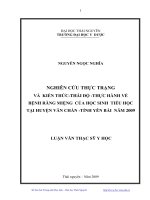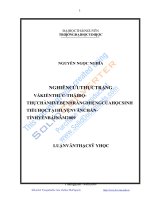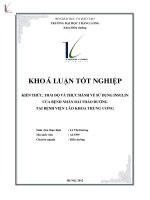Kiến thức thái độ thực hành về bệnh động kinh của giáo viên_KNOWLEDGE_ATTITUDE AND PRACTICE ON EPILEPSY AMONG SCHOOL TEACHERS IN THINGANKYUN TOWNSHIP_ YANGON
Bạn đang xem bản rút gọn của tài liệu. Xem và tải ngay bản đầy đủ của tài liệu tại đây (2.2 MB, 36 trang )
KNOWLEDGE, ATTITUDE AND PRACTICE
ON EPILEPSY AMONG SCHOOL TEACHERS
IN THINGANKYUN TOWNSHIP, YANGON
Dr .Swe Mar Myint Lwin
MBBS, MPH
Assistant Lecturer
Department of Epidemiology
University of Public Health, Yangon
1
1.Introduction
Epilepsy
is one of the most common neurological problems of
childhood and adolescent.
Regarding current status of epilepsy in Myanmar, it is
common and ranks as third among neurological diseases
(Htin-Zaw-Soe et.al .2013).
Teachers are important role in giving health education to the
children , and more influencing on the children than their
parents.
So teachers should have knowledge about epilepsy and first
aid measures of seizure.
2
2.Objectives
2.1.General objective
To study knowledge ,attitude and practice on epilepsy
among school teachers in Thingankyun Township.
2.2 .Specific Objectives
To find out the socio-demographic characteristic of school
teachers
To assess the knowledge and attitude of the school teachers
toward epilepsy.
To identify the practice of school teachers on epileptic
children
To determine the association between socio demographic
characteristic of school teachers and their knowledge,
attitude and practice on epilepsy
3
Conceptual Framework
4
5
3.Research Methodology
3.1.Study design
- Cross-sectional descriptive study
3.2.Study area - Thingankyun township in Yangon
Region
3.3.Study period
- From September to December, 2014.
3.4.Study population- School teachers from four Basic
Education High Schools (BEHS) in
Thingankyun Township , Yangon.
Inclusion criteria
Selected school teachers from 4 BEHS in Thingankyun
Township, Yangon
Both genders (male and female) were included.
Exclusion criteria
Those who were not willing to participate
6
3.5.Sample size determination
The formula , n = z2 p q /d2 is used for sample size
determination.
n = sample size
z = reliability co-efficient at 95% confidence level
p = proportion of school teachers with good knowledge of
epilepsy = 0.5
q = 1 – 0.5 = 0.5
d = desired precision = 0.07
z2 p q /d2 = 1.962 × 0.5 × 0.5 /0.072
= 196
For
non-response rate, 10% of sample size is added to
calculated sample size.
Therefore final sample size is 196 + 20 = 216 participants.
7
3.6.Sampling procedure
Sampling method was two stages simple random sampling
method.
Firstly four Basic Education High schools in Thingankyun
Township were selected randomly and then teachers were
also randomly selected among these four selected BEHS
from this Township.
8
9
3.7.Data collection methods and tools
Before data collection, pre-test was done with
semi structural and self administered questionnaires
(n=15).
3.8.Data management and analysis
The
data analysis were done by using SPSS 16.0 software.
Frequency distribution tables were drawn to describe the
proportion of categories of variables.
For continuous variables, was presented as means and
standard deviation.
Chi Square test was used to find association between
variables.
α was set at 0.05 for statistical significant.
10
3.9.Ethical Consideration
Protocol was submitted to Ethical board of the University
of Public Health for permission to conduct the presented
study.
Written informed consent with thorough explanation about
the study to the school teachers was obtained.
11
4.Findings
Socio demographic characteristic of school teachers
According to this survey, most of the teachers were female
(97.7%) ,single (48.1%) ,Buddhism (97.2%) ,Myanmar
(91.2%) , graduate (81%) and teaching service of more than
10 year (86.6%).
In distribution of rank of school teachers , there are primary
assistant teacher (12.5%) , junior assistant teachers
(46.8%) ,and senior assistant teachers (40.7%) respectively.
All of school teachers had heard about epilepsy.
Their Main sources of information about epilepsy were
from TV/radio , newspaper and journal.
Some (13.4 %) of teachers had the person with epilepsy in
their family, relatives and friends and (86.6%) of school
teachers had not.
12
under 30 years
30-39 years
40-49 years
11
18
46
50-59 years
141
number of school teachers
Figure 1.1.Distribution of age of school teachers
13
male
female
2.31%
97.69%
Figure 1.2.Distribution of gender of school teachers
14
104
98
Single
Married
6
8
Divorced
Widowed
number of school teachers
Figure 1.3.Distribution of marital status of school teachers
15
210
Buddhism
3
3
Christainity
Islam
number of school teachers
Figure 1.4.Distribution of religion of school teachers
16
197
19
Myanmar
Others
number of school teachers
Figure 1.5.Distribution of race of school teachers
17
175
39
2
High School
Graduate
Post-Graduate
number of school teachers
Figure 1.6.Distribution of education level of school teachers
18
187
27
2
0-5 years
6-10 years
>10 years
number of school teachers
Figure 1.7.Distribution of teaching service in years of
school teachers
19
PAT
27
JAT
101
SAT
88
number of school teachers
Figure 1.8.Distribution of rank of school teachers
20
TV/Radio
116
Newspaper/Journal
115
Health Staf
Others
54
28
number of school teachers
Figure 1.9.Distribution of sources of information about
epilepsy
21
187
29
Presence
Not Presence
number of school teachers
Figure 1.10 Distribution of presence of family
member/relative with epilepsy among school
teachers
22
Knowledge, Attitude and Practice level
Regarding knowledge, 53.2 % of teachers had low level of
knowledge.
All of the teachers had heard about the epilepsy and 9.7% of
teachers thought that epilepsy was a kind of insanity and
3.7% answered that epilepsy was a contagious disease.
4.2% of teachers had wrong knowledge that smoking can
cause epilepsy and 24.5% answered that epilepsy was a
blood disorder.
Half of teachers 50.5% did not know that epilepsy can be
treated with anti-epileptic drugs.
14.4% thought that person with epilepsy should avoid
schooling and 23.1% answered that person with epilepsy
should avoid routine works.
23
Regarding
attitude, 53.2% of teachers had poor level of
attitude.
34.3% of teachers agreed that epilepsy was one of the mental
disorders and 9.3% agreed that epilepsy was a fearful and
incurable disease.
Half of teachers 50.5% disagreed that the student with
epilepsy may be as intelligent as other students.
Some 11.6% agreed that child with epilepsy should be placed
in a special classroom.
24
Regarding
practice, 53.7% had poor level of practice.
Regarding the question of “If you see a person or a student
getting seizure in front of you, what would you do ?” ,most
of teachers chose wrong methods of first aid measures.
86.1% answered that they would put something into the
mouth of that person during attack of seizure.
33.8% answered that they would restrain the epileptic
person during attack of seizure.
24.5% of teachers answered that they would apply the
oilment on the body of the epileptic person.
26.4% answered that they would place the key into the
hands of epileptic person to stop seizure.
43.7% answered that they would ask to inhale inhaler or
onion to epileptic person
25









